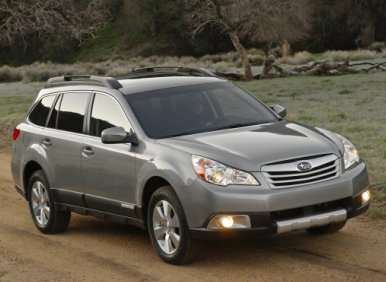Recent Articles
Popular Makes
Body Types
Subaru Outback Used Car Buyer’s Guide
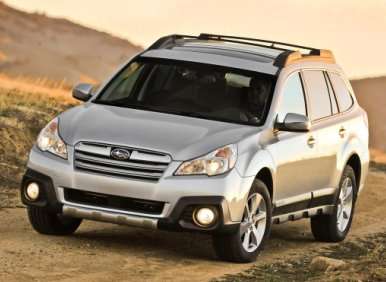
While it might be somewhat difficult to believe now, back in the waning years of the 20th century, before gas prices began to reside permanently north of the four dollar a gallon mark, the vast majority of the American motoring public was infatuated with three- and four-ton four-wheel drive truck-based vehicles known as sport-utility vehicles (SUVs).
Designed originally to carry the family and cargo on excursions deep into the forest where paved roads were few and far between, SUVs were marketed as representing a lifestyle of adventure and excitement. The reality however, was that most of these vehicles were being used to transport kids to soccer matches, and moms to malls—all while unnecessarily guzzling gallons and gallons and gallons of gasoline.
Additionally, based on trucks, those early SUVs drove like trucks. They were heavy, handled poorly and were difficult to park. Further, their elevated ride height made them difficult to get into and out of. Eventually manufacturers came to realize what consumers were really after in this type of vehicle was a high seating position, lots of cargo space, all-wheel drive, and the image.
Subaru was one of the first manufacturers to manifest this realization into a viable product with the Outback. It got the fuel economy of a midsize sedan, handled pretty much like a car, and with its 7.3 inches of ground clearance and all-wheel-drive powertrain, the Subaru Outback was perfect for traversing soft roads and driving confidently in inclement weather—without imposing the costs of driving a gargantuan truck-based SUV.
Subaru introduced the first Outback station wagon in 1994, as a derivative of the second generation Subaru Legacy. At first, the Outback was merely a trim line of Legacy, but by 1996, Subaru got serious about it with a raised suspension system, ancillary lighting instruments and more SUV-like design cues. To date, there have been four generations of the Subaru Outback offered.
This buyer's guide picks up with the second generation of the Outback, launched in model year 2000.
Subaru Outback Used Car Buying Guide: 2000 - 2004
With its perfect blend of off-road capability and on road practicality, by model year 2000 the Subaru Outback had found a ready audience. The model offered 7.3 inches of ground clearance, all-wheel drive as standard equipment, and a reasonable base price. For the vast majority of the American motoring public (or at least that portion of it not overly concerned with image), the Subaru Outback fulfilled all the requirements of an SUV—without the detriments.
At launch, the 2000 Subaru Outback was powered by a 2.5 L 16-valve 165 hp horizontally opposed four-cylinder engine. This power plant was capable of generating 166 foot-pounds of torque. Buyers could choose between either a five-speed manual or a four-speed automatic transmission. Subaru's active all-wheel-drive system was capable of selectively transferring power to the wheels with the most traction, even before slippage occurred.
Those early Outbacks were available in both wagon and sedan configurations. The wagon and the top version of the sedan used the four-speed automatic transmission; all other versions were available with the five-speed manual.
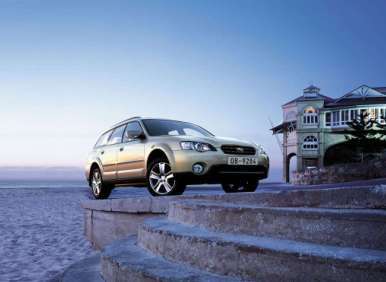
Subaru Outback Used Car Buying Guide: 2000
The model year 2000 Subaru Outback Wagon was available in two states of trim, “Base” and “Limited”. The sedan was offered in Limited trim only. Standard features on the 2000 Subaru Outback Base Wagon included; 16-inch alloy wheels, bucket seats, fog lights, lower body cladding, a heavy-duty suspension system, a keyless entry system, an overhead console, and power brakes.
The model also featured a rear window defroster, tinted glass, two-tone paint, and ABS for all four disc brakes. Cloth upholstery, a power operated driver seat, a rear split bench seat, cruise control, and a tilt steering wheel controlling a power steering system were also included in the base price.
Driver and passenger front airbags, air conditioning, intermittent windshield wipers, power windows and door locks, and a rear window wiper were additional standard features. Daytime running lights, power exterior mirrors, a roof rack, a tachometer, and an AM/FM cassette-based audio system rounded out the standard feature set.
Optional features for the Base Subaru Outback Wagon included a choice of an AM/FM/CD-based audio system or an AM/FM/Cassette/CD-based audio system, a compact disc changer, heated front seats, heated exterior mirrors, and a trailer hitch.
For the model year 2000 Outback Limited Wagon and Sedan, Subaru's product planners specified all of the above standard features plus; a limited slip differential, heated front seats, dual power moon roofs, leather upholstery, leather steering wheel trim, and an AM/FM/Cassette/CD-based audio system.
The Limited Wagon’s options list included a Compact Disc changer, a rear wind deflector, an antitheft alarm system, and a trailer hitch.
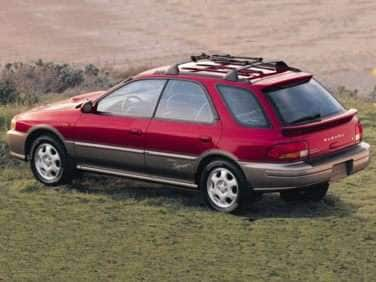
Subaru Outback Used Car Buying Guide: 2001
Two new six-cylinder models were added to the lineup for 2001. The H6-3.0 L.L. Bean Edition and the H6-3.0 VDC, both featuring a 212-hp 3.0 L horizontally opposed engine capable of producing 210 ft-lbs of torque. The four-speed automatic transmission and a center limited slip differential were mated to the 3.0 L engine.
Standard features for the VDC wagon included; vehicle dynamics control (thus its VDC nomenclature), 16-inch alloy wheels, variable intermittent wipers, a rear window defogger, a power glass rear sunroof, an intermittent rear wiper, a roof rack, and a power glass front sunroof. Heated front seats, leather upholstery, a height adjustable eight-way power operated driver’s seat with a manually adjustable lumbar support, a split folding rear seat back with a folding center armrest, and rear ventilation ducts were also included in the base price.
Remote power door locks, heated exterior power mirrors, and power windows with one-touch operation for the driver’s window were Outback VDC standard equipment as well. Additional standard features included cruise control, a front console with storage, front and rear cup holders, front door pockets, and front seat back storage. Outback VDC’s tilt adjustable steering wheel controlled a speed proportional power steering system.
There was also an automatic climate control system, a cargo area light, 12 V front and rear power outlets, plus simulated wood trim on the center console, dashboard and doors. Additionally, the model featured leather trim on the shift knob, a leather and wood steering wheel, and dual illuminating vanity mirrors. The entertainment system was comprised of an AM/FM–single CD player head unit feeding a 200-watt McIntosh amplifier driving 11 speakers.
Options included an air filtration system, an electrochromatic automatic dimming inside rearview mirror with a compass, a cargo net, and wood grained pattern trim.
Safety features included four-wheel ABS, dual front side mounted airbags, a set of child seat anchors, rear door child safety locks, disc brakes at all four wheels, daytime running lights, fog lights, a rear center three-point safety belt, front seatbelt pre-tensioners, stability control, traction control, and an electronic brake force distribution system.
L.L. Bean Edition Wagon buyers got special perforated leather upholstery, a three-year scheduled maintenance package, and center and rear limited slip differentials. But they had to make do without the McIntosh audio system. Other than that, the L.L. Bean Outback was equipped very similarly to the 3.0 VDC.
Outback sedans continued largely unchanged for model year 2001.
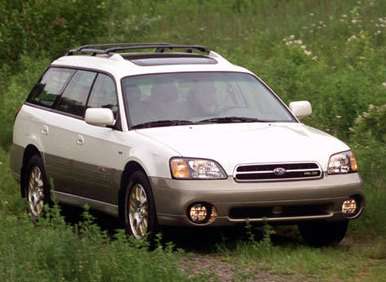
Subaru Outback Used Car Buying Guide: 2002
Outback sedans also got six-cylinder power for model year 2002, when the H6–3.0 L engine migrated from the wagons. This added two additional trim lines to the Outback Sedan line up; “H6–3.0” and “VDC”.
Standard equipment on the H6–3.0 Outback Sedan included; 16 inch alloy wheels, variable intermittent windshield wipers, a rear window defogger, a power glass sunroof, a mechanical center differential, center and rear limited slip differentials, a height adjustable heated eight way power operated driver’s seat with manual adjustable lumbar support, and leather upholstery. The rear seat would fold and featured a pass-through center armrest; there were also ventilation ducts in the rear passenger compartment.
The H6–3.0 Outback Sedan also came with remote power door locks, dual illuminated vanity mirrors, heated power exterior mirrors, power windows with one touch operation for the driver’s window, cruise control, a 12 V rear power outlet, front and rear cup holders, and a tilt adjustable steering wheel controlling a speed proportional power steering rack. The model’s automatic climate control system included interior air filtration. There was simulated wood trim on the center console, dashboard, and the doors. The shift knob featured leather trim, and the wood steering wheel was also trimmed in leather.
The H6–3.0’s audio system used an AM/FM/single-disc CD player head unit with an 80 W amplifier, driving six speakers.
The safety package was composed of four-wheel ABS, dual front side mounted airbags, a set of child seat anchors, ventilated front and solid rear disc brakes, a set of rear door child safety locks, daytime running lights, fog lights, a rear center three-point safety belt, front seatbelt pre-tensioners, electronic brake force distribution, and an emergency interior trunk release.
The 2002 Subaru Outback VDC Sedan did without the rear limited slip differential, but added the 200-watt McIntosh audio system. Just as on the Outback Wagon, the Outback VDC Sedan model got Vehicle Dynamics Control, but the H6-3.0 Outback Sedan did not.
The wagons went through model year 2002 largely unchanged.

Subaru Outback Used Car Buying Guide: 2003
For 2003, the front-end styling was reworked, along with the front suspension. The modifications to the suspension system were intended to reduce body roll and brake dive. By 2003, there were seven variations of the Outback between the Sedans and Wagons. These were the Base Wagon, a Limited Sedan and Wagon, an H6-3.0 Sedan, an H6-3.0 L.L. Bean Edition Wagon, and an H6-3.0 VDC Sedan or Wagon.
The Base and Limited models included air conditioning, a six-way power driver’s seat, heated front seats and side mirrors, cruise control, a CD player, and keyless entry. The Limited models also got dual power moonroofs on the wagon (but just one on the sedan), in addition to upgraded audio systems and leather upholstery.
The H6 models came with automatic climate control featuring air filtration systems, eight-way power driver’s seats and woodgrain-pattered trim. As before, the L.L. Bean Edition bought special leather trim and a three-year scheduled maintenance package.
Both the VDC Sedan and Wagon came with Subaru's stability control system, called Vehicle Dynamics Control, as well as the outstanding McIntosh audio system.
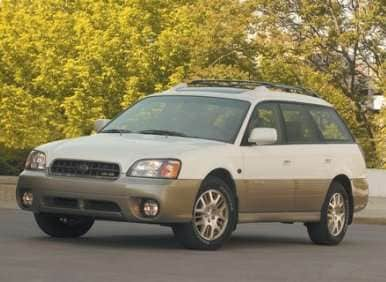
Subaru Outback Used Car Buying Guide: 2004
Model year 2004 was the last year of production of the second-generation Subaru Outback. Red Burl wood interior trim was added and the H6 models got a new alloy wheel. Brown leather was used on the shift knob, handbrake lever and steering wheel of L.L. Bean and Limited models. Subaru celebrated its 35th anniversary in the U.S. with a 35th anniversary special edition of the Outback H6-3.0 wagon. The model was distinguished by a fender-mounted 35th Anniversary badge, and a unique alloy wheel design.
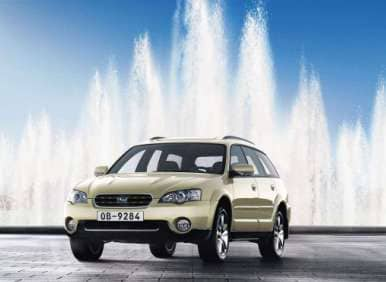
Subaru Outback Used Car Buying Guide: 2005 - 2009
An all-new Outback debuted for the 2005 model year.
The165 hp 2.5 L horizontally opposed four-cylinder returned as the base engine. It was supplemented by a turbocharged version of the same displacement, producing 250 hp and 250 foot-pounds of torque. The 3.0 L flat six-cylinder got a power upgrade to 250 hp and 219 foot-pounds of torque.
A five-speed manual transmission could be mated to either of the 2.5 L engines in the lower trim levels. Upper trim level models running the 2.5 used a four-speed automatic. The six-cylinder models came with a five-speed automatic transmission.
The styling of the vehicle was revised for more upscale appearance and the white lettered tires from the previous model years were done away with for a more sophisticated look. The third-generation model debuted in both sedan and wagon formats, although the sedan was destined to soon be discontinued.
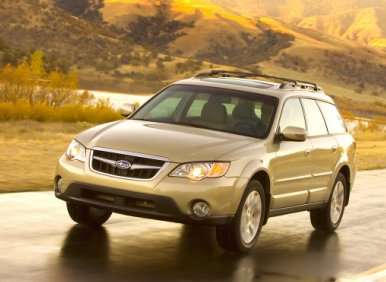
Subaru Outback Used Car Buying Guide: 2005
The 2005 Subaru Outback Wagon was offered in seven trim levels. While the base model was designated “2.5i”, there were also the “2.5i Special Edition”, “2.5i Limited”, “2.5 XT Limited”, “3.0 R”, “3.0R Limited” and the “3.0R L.L. Bean Edition”. The “i” models were normally aspirated, while the “XT” models were turbocharged.
Standard equipment for the base Outback 2.5i Wagon model included 16-inch alloy wheels, a rear spoiler, variable intermittent windshield wipers, an intermittent rear window wiper, a roof rack, and cargo tiedowns. The model employed a viscous center limited slip differential and a rear limited slip differential. The driver and front passenger seat benefited from multilevel heating, and the height adjustable driver’s seat featured manual lumbar support along with eight-way power adjustments. The 2.5i used cloth upholstery and a split folding rear seat back. This Outback model had remote power door locks, heated exterior power mirrors, and power windows with one touch operation for the driver’s window.
Other standard features included cruise control, a front console with storage, front and rear cup holders, an overhead console with storage, a remote trunk release, and front seat back storage. The tilt adjustable steering wheel controlled a speed proportional power steering rack. Air-conditioning, a cargo area light, front reading lights, front and rear floor mats, and dual illuminated vanity mirrors were also included in the base price. The audio system was comprised of an AM/FM–single disc CD player feeding six speakers through a 120-watt amplifier.
Safety kit included ABS for all four disc brakes and electronic brake force distribution. Front and rear head airbags, dual front side mounted airbags, a set of child seat anchors, rear door child safety locks, and a remote antitheft alarm system were included as well. The Outback 2.5i also featured daytime running lights, fog lights, a rear center three-point safety belt, front seatbelt pre-tensioners, and driver and passenger head restraint whiplash protection systems.
The 2.5i Limited came with all of the above plus; power glass front and rear sunroofs, leather upholstery, 12V front and 12V cargo area power outlets, automatic dual zone climate control, and leather trim on the shift knob and steering wheel.
The 2.5 XT added the turbocharged engine plus; 17-inch wheels, sport seats, a four-way power front passenger seat, a folding center armrest in the split folding rear seatback, and turn signals integrated into the exterior rearview mirror housings.
To all of that, the 2.5 XT Limited’s standard equipment list added manual adjustable lumbar support for the front passenger’s seat and leather upholstery.
Moving up to the 3.0 R L.L. Bean Edition Wagon added the 250 hp horizontally-opposed six-cylinder engine, the five-speed automatic transmission, audio controls on the leather and wood steering wheel, and an auto dimming electrochromatic inside rearview mirror.
The 3.0 R VDC Limited Wagon added a universal remote transmitter for garage doors and security systems, stability control, traction control, and a seven-speaker 120-watt AM/FM in-dash six-disc CD changer with CD MP3 playback capability and a subwoofer.
The sedan was offered in but one state of trim, designated 3.0 R and was equipped largely the same as the 3.0 R L.L. Bean Edition Wagon, without the L.L. Bean’s special leather trim and color palette.
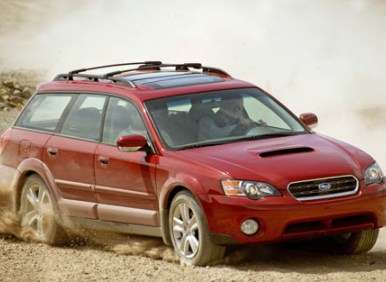
Subaru Outback Used Car Buying Guide: 2006
An L.L. Bean version of the Sedan debuted. The sedan was also offered with the normally aspirated four-cylinder engine in Limited trim.The normally aspirated four-cylinder engine was reconfigured to run a revised variable valve lift system, which bumped its horsepower output to 175. A navigation system was added to the upper trim levels.
Subaru Outback Used Car Buyer’s Guide: 2007
Rather than offering a lot of optional features, Subaru’s product team offered a lot of different versions of the Outback. By 2007, the seven versions of the Outback Wagon were 2.5i Basic, 2.5i, 2.5i L.L. Bean Edition, 2.5i Limited, 2.5i Limited L.L. Bean Edition, XT Limited and 3.0 R L.L. Bean. The sedan was available in 2.5i Limited and 3.0R L.L. Bean trim levels.
For model year 2007, standard equipment on the entry-level Basic wagon included 16-inch steel wheels, roof rails, air-conditioning, a six-speaker stereo with an auxiliary MP3 player input jack, an exterior temperature display, and a full array of power accessories.
The 2.5i wagon built upon that with 17-inch alloy wheels, a limited-slip rear differential, crossbars for the roof-rails, a pair of heated exterior mirrors, a de-icing grid in the windshield for the wipers, a power driver’s seat, and a pair of front seat heaters.
The 2.5 L.L. Bean Wagon folded in a dual-zone automatic climate control system, an in-dash CD changer, a navigation system, and L.L. Bean floor mats.
To get to the 2.5i Limited, Subaru's product planners dropped the nav system, but added a set of body-color door handles, a power glass sunroof with a double-panel design for the wagons, and leather upholstery.
The 2.5i Limited L.L. Bean Edition included all of the above—as standard kit.
The Outback XT Limited and 3.0 R L.L. Bean models got the more powerful engines, but were equipped largely the same. They also offered the navigation system as an option.
The XT Limited was further distinguished by a dark interior treatment with simulated aluminum interior trim and contrasting red electroluminescent gauges. For a more upscale appearance, the 3.0 R used artificial wood accents but the steering wheel was made of genuine mahogany and trimmed with leather.
Subaru Outback Used Car Buyer’s Guide: 2008
Outback Sedan was dropped. The Wagon’s front and rear fascias got an appearance update, and a new instrument panel was installed.
Subaru Outback Used Car Buyer’s Guide: 2009
The L.L. Bean trim lines were dropped, stability control was added to all models, and a nine-speaker audio system was installed in all models except the Base 2.5i iteration of the Outback Wagon.

Subaru Outback Used Car Buying Guide: 2010 – Current (2012)
Larger and more spacious, the 2010 Subaru Outback evolved into an apparition closer to the crossover utility vehicles that (ironically) were spawned to imitate it. The turbocharged engine was dropped, but the flat six got a displacement increase to 3.6-liters. This endowed it with a horsepower output of 256 and a torque capability of 247 foot-pounds.
Stability control and traction control were made standard equipment across the entire Outback lineup. The five-speed manual transmission was supplanted by a six-speed manual transmission, and the two automatics gave way to a continuously variable transmission.
In addition to the newfound size, more luxury features were added to broaden the Outback's appeal. Items like Bluetooth telephony and audio streaming and rearview backup cameras, in addition to high-powered stereo systems from the likes of Harman/Kardon moved the Outback's attitude more toward the upscale aspect of the marketplace.
